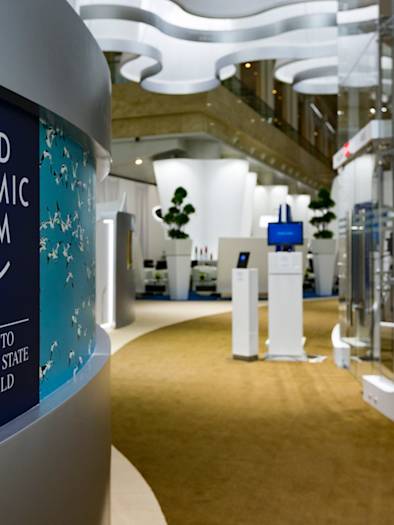
COP15 in China: Why businesses should nurture their future success in nature – and how they can do it
At the first part of the UN biodiversity summit in Kunming, global leaders took a modest yet promising step towards strengthening biodiversity governance and securing a nature-positive future. A Paris Agreement-style accord for biodiversity may now lie over the horizon at COP15’s second phase next spring.
This month, China hosted the first phase of a major two-part UN biodiversity summit that aims to set a new global framework for biodiversity governance through 2030. After being delayed twice due to the pandemic, the 15th Meeting of the Parties to the Convention on Biological Diversity (CBD) – or COP15 in short – was split into two chapters, the first of which recently concluded in Kunming and saw more than 100 countries sign a new political declaration to guide final negotiations on the draft nature treaty.
Although overshadowed by the much better-known COP26 – set to begin shortly in Glasgow – COP15 is just as important. The world has seen rapid and often unprecedented biodiversity losses in recent years, with one million species now at threat of extinction. Given that more than half of global GDP is moderately or highly dependent on nature and its services, according to research by the World Economic Forum (WEF), a failure to act now and reverse current trends would lead to severe consequences for economies, societies, and human health.
Yet while nature’s contribution to humanity is undeniable, awareness of the urgency of protecting biodiversity and halting the unsustainable use of natural resources has lagged far behind that of fighting climate change. It is now critical to continue elevating biodiversity in the public’s mind and on political and business agendas in the build-up to COP15’s second phase in spring 2022, when global leaders will hopefully ratify a game-changing accord that will help transition the world onto a nature-positive trajectory.
China unveils new global and domestic endeavors to protect nature
Addressing the Leaders’ Summit of COP15, President Xi outlined a series of new plans and initiatives to help safeguard biodiversity – both globally and at home. On the international front, he announced plans to establish the Kunming Biodiversity Fund to support emerging economies’ efforts in fighting nature loss, backed by an initial contribution from China of 1.5 billion yuan (US$233 million). He also called for and welcomed other countries to contribute to the new fund.
The new international fund could eventually play a key role in expanding the support available to biodiversity-rich developing nations. However, it is critical that other countries also pledge their own contributions to transform the fund into a multi-billion-dollar vehicle capable of helping to address the massive shortfall in global funding for conservation. When phase two of COP15 takes place next spring, there will likely be an influx of new commitments made as other governments step up. But it will be a long road ahead for the international community to successfully mobilize the full funding that will be needed to tackle biodiversity degradation.
President Xi also announced a series of new plans and initiatives for the home front, most notably the launch of China’s first-ever group of national parks. Covering a total protected area of more than 230,000 square kilometers (88,800 square miles), the five new national parks aim to safeguard the habitats of endangered species like Siberian tigers and leopards in the northeast, giant pandas in the southwest, and black-crested gibbons on the southern island of Hainan.
In addition, President Xi said that China will launch further policies to help achieve its 2030/2060 climate goals, including plans and supportive measures to curb emissions in key sectors. He also reiterated the country’s commitment to accelerating the development of renewable energy, including stepping up the planning and construction of wind and solar power bases in desert regions.
Kunming Declaration adopted to guide upcoming negotiations
As the main outcome of COP15’s first phase, more than 100 countries adopted the Kunming Declaration. Signatory nations pledged “to develop, adopt, and implement an effective post-2020 global biodiversity framework that would put biodiversity on a path to recovery by 2030 at the latest, towards the full realization of the 2050 Vision of ‘Living in Harmony with Nature.’”
While not committing to any specific targets, the declaration is intended to provide political guidance for further negotiations on the draft global treaty, scheduled for next January in Geneva. Some of the key elements addressed in the declaration included:
Mainstreaming biodiversity across government decision-making
Phasing out and redirecting subsidies that damage nature
Strengthening the rule of law
Ensuring the full and effective participation of indigenous peoples and local communities
For global leaders, the key will be taking what is now simply a political statement and turning it into an action plan for protecting nature – a 2030 roadmap which features ambitious yet pragmatic, measurable targets and is backed by sufficient funding. This is especially important after a UN report last autumn revealed that the world had failed to fully achieve any of the 2020 targets set at COP10 in Aichi, Japan.
Rethinking the business world’s relationship with natural systems
Governments and civil society alone will not be able to reverse the loss of biodiversity. Successfully transitioning the world onto a nature-positive trajectory will require full buy-in from the private sector as well. Yet while biodiversity underpins economies, markets and businesses have mostly been designed to exploit nature rather than protect it.
But that is no longer sustainable. If the world fails to act now and stop nature loss, it could cost the global economy trillions of dollars, disrupt countless industries, and affect millions of people’s lives. Alternatively, the shift towards a nature-positive economy could create an incredible US$10.1 trillion of business opportunities and generate 395 million jobs by 2030, according to a study by the WEF.
Fortunately, there has been growing recognition within the business community not only about the dire risks of persisting with business-as-usual but also the immense gains to be reaped by embedding biodiversity within their decision-making. For instance, more than 1,000 companies, representing US$4.7 trillion in annual revenue, have signed Business for Nature’s Call to Action urging governments to adopt policies now to reverse nature loss by 2030.
However, while momentum is building, businesses still have a long way to go. Historically, companies have been much more active on the climate agenda, and biodiversity continues to lag way behind on most corporate agendas. One major reason is that the business community has long struggled to understand the sheer complexity of biodiversity and the countless species and ecosystems around the world that need to be protected. The very multidimensionality of the nature agenda has made it much more challenging to come up with a single indicator as simple as reducing greenhouse gas emissions.
That is where the post-2020 global framework for biodiversity should come in. Nothing can replicate the need for strong policy frameworks that will drive action. For example, the Paris Agreement provided a clear framework that governments and businesses have actively responded to with concrete measures. Unless COP15’s second phase produces a similarly robust framework for biodiversity – one that companies can easily link back to and use to scale up their own efforts – then hopes to systemize the corporate world’s approach to nature protection could remain unrealized.
Key recommendations
For businesses, while the journey towards becoming nature-positive will not be an easy one, it will empower them to reinvigorate their purpose, strengthen their license to operate, and unlock greater profits. And having just entered the half-year period between COP15’s first and second chapters – and with COP26 about to begin shortly – it is an opportune time for companies to rethink their relationship with nature and how to better position themselves for future success.
As they do so, here are six recommendations for them to consider:
Be an early mover.
Act with a sense of urgency and charge out the gate in support of COP15’s new roadmap for the next decade – not only because it’s the right thing to do, but because those that are forward-thinking and take steps to transform early also stand to gain immensely. By capitalizing on the growing movement to protect nature and positioning themselves at the center of the transition, companies can secure a significant first-mover advantage that will enable them to capture new business opportunities and strengthen their corporate reputations with consumers, regulators, and investors. So don’t sit on the sidelines and get left behind in the “Super Year for Nature.”
Embed biodiversity at the heart of business decision-making.
Naturalize biodiversity throughout your corporate DNA by orienting your business model with the drive towards a nature-positive future. Take internal action within supply chains and business operations and external action by ramping up regulatory and other stakeholder engagement, positioning your company as a leading public champion and advocate for biodiversity. And redefine risk beyond a narrow view of short-term material risks by taking the health of nature explicitly into account as a threat to your own business health. This is imperative because the continued degradation of natural systems at current rates will eventually lead to massive disruptions throughout the global economy – and no company would be immune from the fallout.
Synergize efforts on nature and the race to net zero.
As the world confronts the dual biodiversity and climate crises, businesses don’t need to prioritize addressing one over the other. These global emergencies are deeply intertwined, and by harmonizing their approaches, companies can establish a more holistic sustainability strategy that effectively plays to both agendas – and ultimately delivers a much wider impact. And given that there have long been far higher levels of private sector participation in the fight against climate change than nature loss, many businesses can leverage their achievements and deep experience in the climate space to inform their biodiversity efforts.
Align with the new biodiversity framework and set smart goals.
The 2030 blueprint will provide businesses with a new framework that they can easily connect with and leverage to scale up their own nature-focused initiatives. Indeed, many of the draft targets are directly relevant to the private sector, creating huge space for companies to get involved, contribute, and help fill the gaps – around financing, knowledge and expertise, technical solutions, and more. After assessing the framework’s targets and identifying where their business would be best aligned to make a difference, companies can then set their own biodiversity goals. These should be specific, measurable, and feasible, rather than overly ambitious targets which are unlikely to be achieved. Clear action plans for realizing them should also be drawn up.
Leverage dynamic partnerships and multi-stakeholder coalitions.
Don’t act alone. No single actor can halt and reverse the tide of biodiversity loss on their own. This will be a framework for all, and its success will depend on collective efforts, with a high degree of coordination across policymakers, civil society, financial institutions, and the business community. Companies will have to work in a highly collaborative environment where they deepen existing partnerships, forge new ones, and join the multi-stakeholder platforms that can add the capacity and scale to achieve systemic change, such as Business for Nature and the Global Partnership for Business and Biodiversity.
Weave nature into corporate sustainability narratives.
If you preserved a tree in the forest, did anyone hear it? Companies should harness the power of storytelling to inform their target audiences exactly what they’re doing to protect nature and the meaningful impacts being delivered. This will require the development of differentiated messaging that resonates with various groups, depending on their level of familiarity with the topic. For instance, highly technical communications may work best with the experts at environmental NGOs, but explaining the complexities of biodiversity in simple, compelling ways will be critical to engaging effectively with consumers.
Read H+K China’s full report on the key outcomes from COP15’s first phase, what comes next, and why businesses should continue accelerating their journey towards becoming part of the solution rather than the problem – and how they can do so: Accelerating the Global Movement to Safeguard the Natural World
In August 2021, H+K China’s Government & Public Affairs (GPA) practice also launched an exciting new offering which provides clients with a dynamic suite of strategic communications and public affairs services around COP15, the world’s most important biodiversity conference in a decade. More information is available here.
About our Government & Public Affairs Practice in China:
Bespoke policy and political expertise. As local and global policy experts, we know that politics doesn’t operate in a vacuum and that Public Affairs can’t either. More than ever before, it is vital that businesses understand and adapt not only to the changing political and regulatory environment, but also to the cultural and societal expectations impacting their futures.
At H+K China, we see the whole picture. We partner with our clients to find solutions. We help them successfully engage with their policy and regulatory stakeholders, to pre-empt and respond to the fundamental policy challenges facing their businesses. We focus on outcomes rather than processes and enable our clients to move with and shape public opinion.







